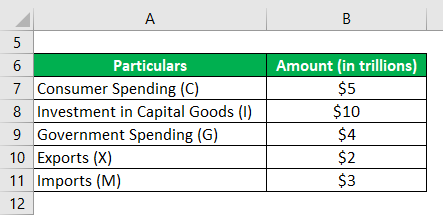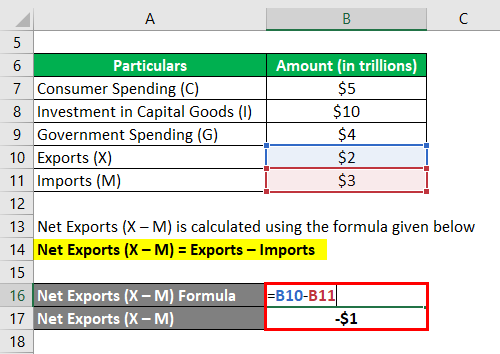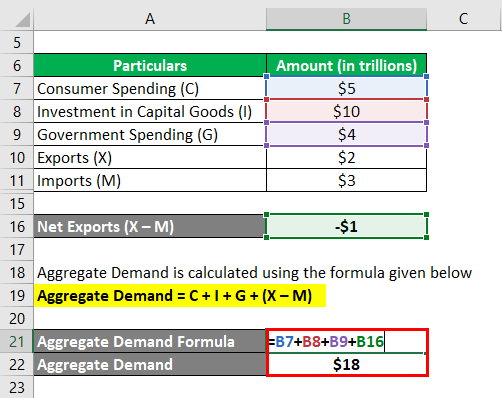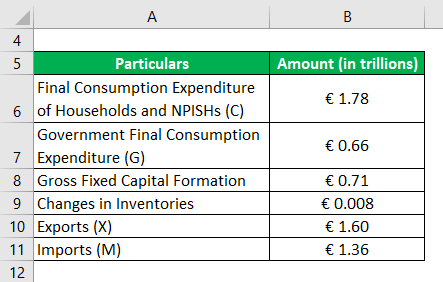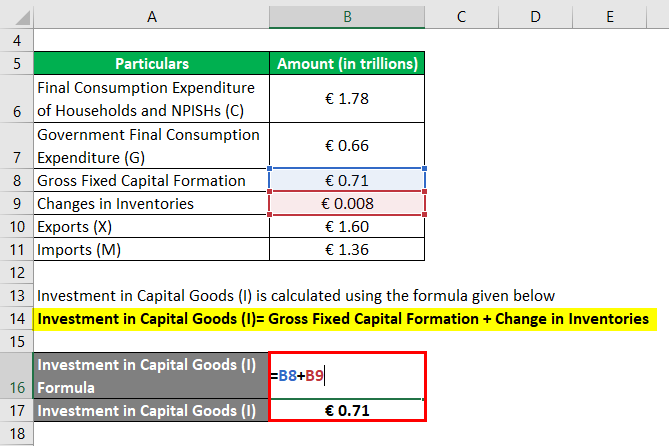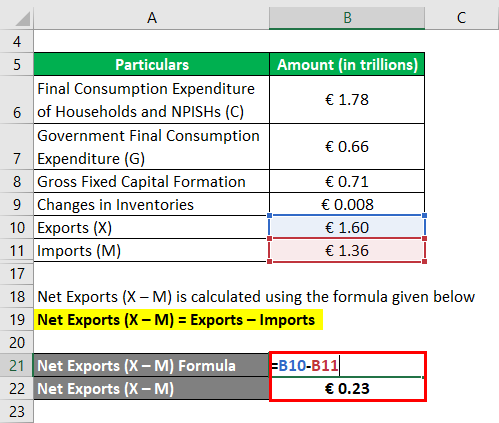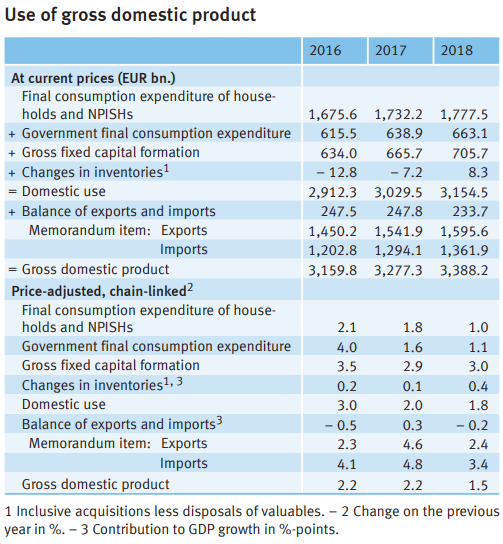Updated July 26, 2023
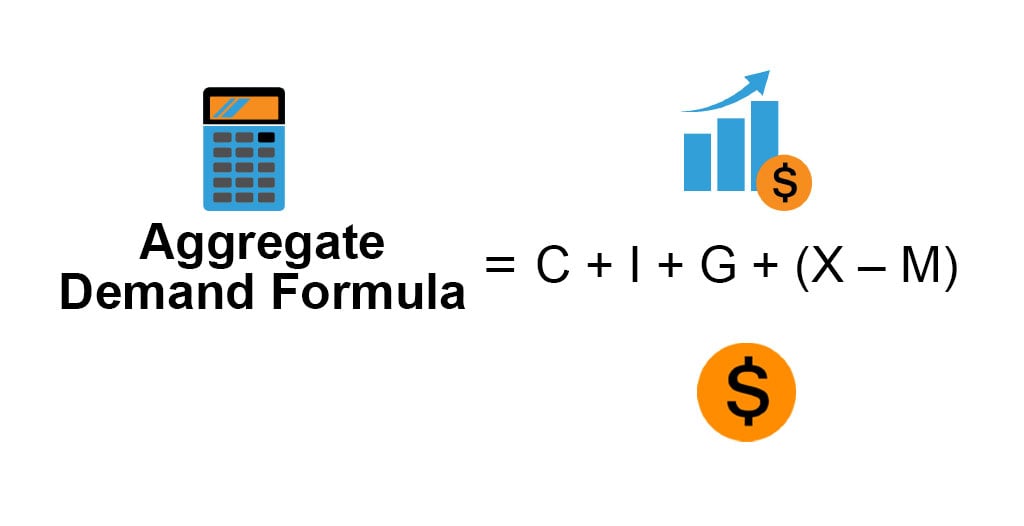
Aggregate Demand Formula (Table of Contents)
What is the Aggregate Demand Formula?
The term “aggregate demand” refers to the overall demand for all goods and services produced in an economy during a given period of time, preferably a year.
In other words, aggregate demand is a macroeconomic term that describes all that consumers buy at a certain given price level during a given period. Since everything that is consumed domestically in an economy can be considered to be the same as what is produced in the economy during that period, such aggregate demand of an economy can be considered equivalent to its gross domestic product. The formula for aggregate demand can be derived by adding consumer spending, investment in capital goods, government spending and net exports. Mathematically, it is represented as,
where,
- C = Consumer Spending
- I = Investment in Capital Goods
- G = Government Spending
- X – M = Net Exports
- Net Exports (X – M) = Exports – Imports
Examples of Aggregate Demand Formula (With Excel Template)
Let’s take an example to understand the calculation of Aggregate Demand in a better manner.
Aggregate Demand Formula – Example #1
Let us take the example of an economy with consumer spending on goods and services of $5 trillion, investment in capital goods of $10 trillion and government spending of $4 trillion during 2018. During the same period, the country exported goods and services valued at $2 trillion while it imported goods and services worth $3 trillion. Calculate the aggregate demand of the country based on the given information.
Solution:
Net Exports (X – M) is calculated using the formula given below
Net Exports (X – M) = Exports – Imports
- Net Exports (X – M) = $2 trillion – $3 trillion
- Net Exports (X – M) = – $1 trillion
Aggregate Demand is calculated using the formula given below
Aggregate Demand = C + I + G + (X – M)
- Aggregate Demand = $5 trillion + $10 trillion + $4 trillion + (- $1 trillion)
- Aggregate Demand = $18 trillion
Therefore, the country’s aggregate demand for the year 2018 stood at $18 trillion.
Aggregate Demand Formula – Example #2
Let us take the example of Germany to illustrate the calculation of aggregate demand with a real-life example. As per the latest release by the German government on, the following information is available pertaining to aggregate demand (or GDP) for the year 2018.
Solution:
Investment in Capital Goods (I) is calculated using the formula given below
Investment in Capital Goods (I)= Gross Fixed Capital Formation + Change in Inventories
- Investment in Capital Goods (I) = €0.71 trillion + €0.008 trillion
- Investment in Capital Goods (I) = €0.71 trillion
Net Exports (X – M) is calculated using the formula given below
Net Exports (X – M) = Exports – Imports
- Net Exports (X – M) = €1.60 trillion – €1.36 trillion
- Net Exports (X – M) = €0.23 trillion
Aggregate Demand is calculated using the formula given below
Aggregate Demand = C + I + G + (X – M)
- Aggregate Demand = €1.78 trillion + €0.71 trillion + €0.66 trillion + €0.23 trillion
- Aggregate Demand = €3.39 trillion
Therefore, Germany’s aggregate demand for the year 2018 stood at €3.39 trillion.
Source Link: Gross Domestic Product
Explanation
The formula for aggregate demand can be derived by using the following steps:
Step 1: Firstly, determine the consumer spending within a country which includes public expenditure that is intended for the purchase of durable goods, nondurable goods, and services. It doesn’t include any expense towards investment. It is denoted by C.
Step 2: Next, determine the investment in capital goods which includes public (especially business) spending for the purchase of a building, equipment, etc. It is denoted by I.
Step 3: Next, determine the government spending which includes expenditure intended for infrastructure and other similar capital investments. It is denoted by G.
Step 4: Next, determine the next export of the country during a given period. It is the total exports minus the total imports. Exports are the aggregate value of the goods and services produced domestically and sold abroad, while imports are the summation of all goods and services purchased from abroad. It is denoted by (X – M).
Step 5: Finally, the formula for aggregate demand can be derived by adding consumer spending (step 1), investment in capital goods (step 2), government spending (step 3) and net exports (step 4) as shown below.
Aggregate Demand = C + I + G + (X – M)
Relevance and Uses of Aggregate Demand Formula
The concept of aggregate demand is a very important one as the economic analysts can use it as a proxy for the GDP of an economy. As such, it can be used to compare the economic output of an economy across different periods. Inherently, the GDP of an economy is seen as a good indicator of economic growth and countries with steady and healthy GDP growth are considered to be strong economies. Some of the growing economies of the world include countries like India and China, while the US and German are some of the matured economies.
Some of the economic factors that can impact the aggregate demand of a country include interest rates, average household income, inflation rate, and currency exchange rate.
Aggregate Demand Formula Calculator
You can use the following Aggregate Demand Formula Calculator
| C | |
| I | |
| G | |
| (X - M) | |
| Aggregate Demand | |
| Aggregate Demand = | C + I + G + (X - M) | |
| 0 + 0 + 0 + 0 = | 0 |
Recommended Articles
This is a guide to Aggregate Demand Formula. Here we discuss how to calculate Aggregate Demand Formula along with practical examples. We also provide an Aggregate Demand calculator with a downloadable excel template. You may also look at the following articles to learn more –
